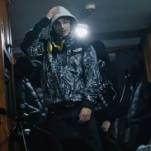Hellman opens the film, written by Variety executive editor and longtime Hellman friend Steven Gaydos, with an act of cinematic sleight of hand that doubles as an overture for what’s to come. Speaking to a woman with a camera (Dominique Swain), a blogger in the North Carolina community in which most of the film is set, a filmmaker named Mitchell Haven (played by Tygh Runyan; note his character’s initials) pops a DVD of his latest movie, Road To Nowhere, into a laptop. As it begins to play, the camera slowly zooms in on the laptop screen until its image fills the frame and the world around the movie within the movie melts away. After a languid scene punctuated by a gunshot, the credits start to roll for Road To Nowhere, “a Mitchell Haven picture.” The reality of the film within the film has supplanted the film itself, even stealing its credits sequence.
That’s only Road To Nowhere’s first hall-of-mirrors moment. Runyan’s film involves a double-cross, a murder, a cover-up, and a femme fatale, but the details remain fuzzy. So does the film-within-the-film’s relationship to the events that inspired it, or their connection to its leading lady (Shannyn Sossamon), an unknown cast in a fit of inspiration. Runyan falls for her, and they spend their downtime watching famous films in their hotel room. Watching him sob at the conclusion of The Spirit Of The Beehive, she asks, “How many movies have you seen?” “You shouldn’t really ever ask a filmmaker that,” he replies. “We don’t ever really want to admit how much time we spend obsessing over other people’s dreams.”
That’s as close as Road To Nowhere comes to offering clues for decoding the way its reality keeps shifting. Told via a fractured chronology, it keeps playing with the divide between truth and fiction, identity and performance, in ways that remain compelling even in the moments when the film feels opaque to the point of frustration. Those moments feel like part of the design, though a few other elements, like Sossamon’s not-quite-there performance as a woman of ineffable mystery, don’t gel into the surroundings. (Another semi-forgotten it-girl of years past, Swain fares better in her earthier role.)
The tone and subject at times recall David Lynch’s Lost Highway and Mulholland Dr., but the approach is Hellman’s own. As Sossamon prepares to take a meeting, the camera lingers on her as she laces up her shoes and fixes her hair, as if the preparations meant as much as the encounter itself. It’s possible, even likely, that viewers will leave Road To Nowhere with a much better understanding of the characters than the plot. Dreamers, after all, have more shape than their dreams.









































